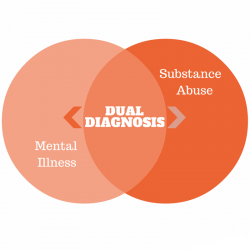Understanding the Dual Diagnosis Definition
According to the U. S. National Library of Medicine, dual diagnosis definitions were first developed in the 1980s in response to the large number of people displaying symptoms of both mental illness and drug addiction. The dual diagnosis definition centers on the co-occurrence of mental illness and drug addiction and the likelihood of these conditions developing together.
As of 2007, an estimated 2.7 million American adults struggled with dual diagnosis conditions. Understanding the dual diagnosis definition is a necessary first step towards ensuring a person receives the type of treatment that best addresses his or her treatment needs.
We can help you find the best treatment for you. Call 800-895-1695 toll free today.
Co-Occurring Conditions
Co-occurring conditions, also known as dual diagnosis disorders, take shape in response to chemical imbalances that form in the brain. As both drug addiction and mental illness develop out of abnormal brain chemistries, the likelihood of contracting a dual diagnosis condition is all the more probable when one condition exists.
Mental disorders most likely to co-occur with drug addiction include:
- Schizophrenia
- Personality disorders
- Anxiety disorders
- Depression disorders
According to the National Institute on Drug Abuse, drug addiction falls under the classification of mental illness in spite of the chemical effects of drugs on the brain. In this respect, a dual diagnosis definition entails two forms of mental illness, one of which involves substance abuse behaviors.
You are not alone. Call 800-895-1695 toll free to find treatment.
The Relationship Between Substance Abuse & Mental Illness
The relationship between drug addiction and mental illness lies at the heart of the dual diagnosis definition. According to the National Alliance on Mental Illness, this relationship can take three forms:
- For people struggling with pre-existing mental disorders, the effects of drugs/alcohol on brain function can worsen the symptoms associated with a mental disorder.
- People affected by mental disorder may use drugs/alcohol as a form of self-medication to gain relief from disorder symptoms.
- For people with no pre-existing disorders, drug/alcohol use can trigger the beginnings of a mental disorder.
Since both conditions thrive on brain chemical imbalances, the presence of one predisposes a person to developing the other.
Prevalence

Co-occurring disorders are also referred to as ‘dual diagnosis’.
The components that make up a dual diagnosis definition have a bearing on the prevalence of these conditions when considering rates of drug addiction and mental illness. On average, someone suffering from a mood or anxiety-based disorder is twice as likely to develop a substance abuse disorder.
The same rings true for people diagnosed with certain personality disorders, such as antisocial personality and conduct disorder. Likewise, drug addicts (and alcoholics) are also twice as likely to develop a mood or anxiety-based disorder. In effect, the dual diagnosis definition can be a strong predictor in cases where certain types of mental disorders exist.
For help finding treatment call 800-895-1695 toll free anytime.
Diagnosis & Treatment Considerations
The symptoms associated with mental disorder closely resemble those brought on by drug addiction. Once a person develops a dual diagnosis condition, it becomes difficult to distinguish symptoms of drug addiction from those caused by psychological dysfunction.
For these reasons, a clear dual diagnosis definition is necessary in order to address each person’s individual treatment needs. Because of the strong relationship between mental illness and drug addiction, it’s essential to treat both conditions as opposed to just one or the other.



